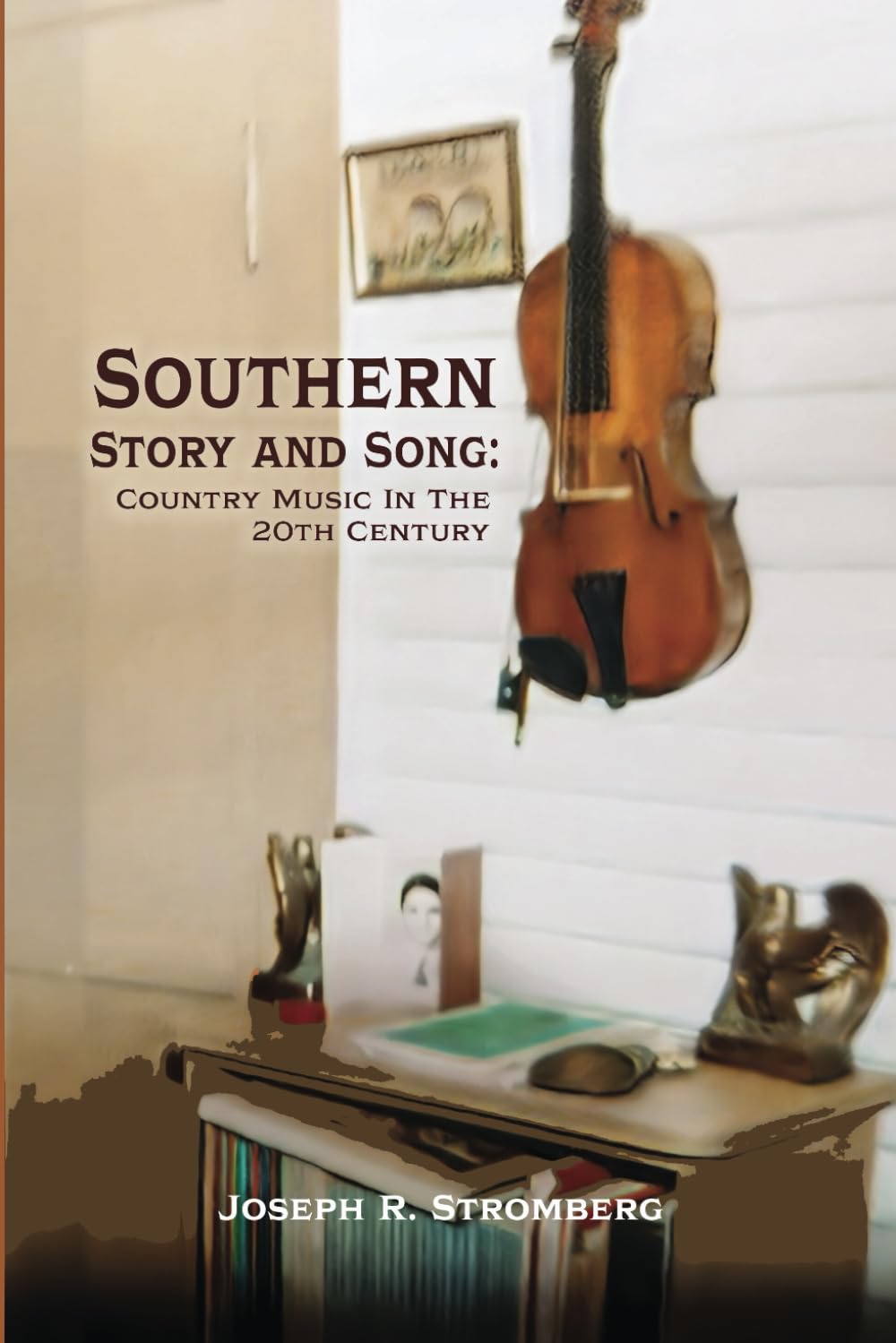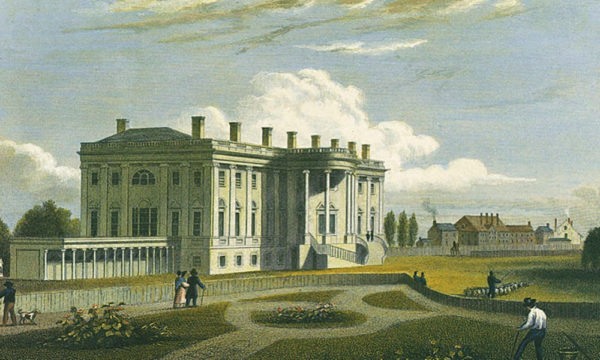A review of Southern Story and Song: Country Music in the 20th Century (Shotwell, 2024) by Joseph R. Stromberg
Readers who have enjoyed the articles posted here at Abbeville by Joseph R. Stromberg will be as excited as I was to learn he’d written a book about country music. This excellent book explores the rich cultural tapestry of Southern music, highlighting its diverse influences from Scots, Irish, German, French, and African traditions. Additionally, it traces the evolution of country music from spirituals to honky-tonk, Bluegrass, and the Nashville Sound, emphasizing storytelling and social realism. Stromberg even touches on the global reach of country music, noting its impact in Australia, Canada, Sweden, the UK, Germany, Japan, Korea, and the Caribbean, most of which was new to me. The book also addresses the intersections of country music with blues and rock, the role of black musicians, and the use of country music in film. It presents the essence of country music as a universal yearning for connection and shared humanity.
Stromberg opens by introducing the rich, cultural tapestry of Southern music in general, and the vital importance of challenging all the stereotypes about country music. He notes the cultural blend or “fusion” so vital to country music and references historian Max Savelle’s work on the cultural threads woven into Southern music, and discusses the role of religion in shaping the early Southern sound, particularly the impact of the Great Awakening on the development of spirituals.
I was extremely pleased to read Stromberg’s support for Abbeville’s recent declaration, in conjunction with its 1607 Project, that American music originated in Colonial Jamestown. He describes black musicians playing jigs and reels at colonial Virginia gatherings, highlighting the vital cultural exchange of the time. Stromberg paints a vivid picture of this cultural exchange in music and dance, where supposedly separate worlds were actually intertwined, by referencing James Kibler’s documentation of the typical mix of instruments found on the plantation such as pianos, banjos, and fiddles, with black fiddler always leading the way. This created a unique blend of sounds that served as a weather vane to the cultural fusion going on throughout Southern society as a whole—a fusion that could never have taken place in the rigidly segregated society we have been taught falsely to believe was predominant in the Old South.
Stromberg explains that country music is about social realism, reflecting life’s ups and downs, and he gives examples of country songs that capture themes of love, heartbreak, family, and home, including such classics as “Together Again” by Buck Owens and “D-I-V-O-R-C-E,” popularized by Loretta Lynn but composed by Bobby Braddock and Curly Putman. Additionally, Stromberg discusses the themes of place and belonging in country music, particularly in songs like Bobby Bare’s “Detroit City” and Hank Williams Jr.’s “Dixie on My Mind” that speak to the longing for home and the sense of displacement a lot of Southerners felt as they migrated to other parts of the country during and after the Great Depression. Songs such as these offered people comfort and a way to stay connected to their roots, even when they were far away from home. Stromberg also describes the obvious theme of agrarian life in early country music, as farming was just a natural backdrop for the Southern lifestyle. However, as the South industrialized, farming became something people yearned for, representing a simpler way of life that was slipping away. Such are the memories that get preserved in country music, which becomes a way to hold on to that nostalgia.
In an excellent exploration of storytelling and social realism in country music, the author explores how it reflects political and social upheavals, with a strong streak of populism. The lyrics of Merle Haggard and Johnny Paycheck gave voice to the working class and their struggles, and that populist strain is still around today, even sparking controversy with artists like Oliver Anthony. Country music has always been a platform for these social commentaries reflecting the concerns and aspirations of working people.
The first part of the book includes something totally unexpected: an exploration of the parallels between country music and Icelandic sagas, noting their common focus on ordinary people and themes of individual freedom vs. community bonds. The sagas from medieval Iceland share some surprising similarities with Southern literature and, by extension, country music. Stromberg explains the use of laconic dialog in both Icelandic sagas and Southern literature, as they employ understated humor that’s both witty and poignant, so that it’s not just about the content of the stories, but also about the way they’re told. Hence the crucial role of Southern dialects in country music, as the distinctive features of Southern speech and the unique Southern vocabulary directly shape the overall sound and feel of the music. Southern dialects have Celtic roots, which is a signature element of Southern speech that naturally found its way into country music. You could probably sing a country song without these elements, but it wouldn’t sound right. It’s a code that signals authenticity, like a secret handshake that allows Southerners to recognize their own language and culture in the music. Therefore, it all comes back to Stromberg’s “fusion thesis”—the blending of influences and cultures that came together so uniquely in the South.
Following the preliminary background of country music’s origins, Stromberg explores a detailed evolution of musical styles from country’s early pioneers to the birth of new subgenres, with each decade adding new layers and complexities. He mentions key figures like Vernon Dalhart and Jimmie Rodgers, who recorded country hits in the 1920s, and he discusses the rise of honky-tonk in the mid-20th century, with artists like Ernest Tubb leading the way. Stromberg also explains the unique blend of traditional Appalachian folk music and modern influences in Bluegrass, as defined by its inventor, Bill Monroe.
In a discussion of the Nashville Sound, Stromberg describes the shift towards a more polished style in the 1950s and 1960s, featuring artists like Tennessee Ernie Ford and Jim Reeves. He describes the backlash against the Nashville Sound among those who felt it sacrificed authenticity for a mainstream appeal. He also explains the emergence of country rock in the late 1960s, blending country music with rock ‘n roll by iconic bands such as The Byrds, the Flying Burrito Brothers, and The Eagles, who pioneered this genre, blending country music instrumentation and storytelling with the raw energy of rock. It was a time of both preservation and innovation, and artists like Ricky Skaggs and Emmylou Harris, who had deep roots in Bluegrass and folk music, played a vital role in keeping those traditional sounds alive. Furthermore, singers and composers like Alan Jackson and Dwight Yoakam, who emerged in the 1980s and 90s, blended classic country music themes and instrumentation with their own unique styles. These artists managed to bridge the gap between tradition and innovation, ensuring that those core values of country music continued to resonate.
The most striking part of the second half of the book is the fascinating discussion of the global reach of country music, and how these changes and challenges played out on the international stage, which is something I’d never considered very much. Australia has a rich tradition of country music and has grappled with similar questions of identity and authenticity, with artists like Reg Poole and Keith Jamieson, who recorded a song called “Don’t Let Them Murder Tamworth,” a protest against the perceived threat to their own country music heritage celebrated at the massively popular Tamworth Country Music Festival in New South Wales. Additionally, Stromberg highlights Canada’s strong affinity for country music, with artists like Fred Eaglesmith and Sylvia Tyson capturing the essence of Canadian life. There’s also a discussion of Sweden’s vibrant country and Bluegrass scene, with bands like G2 and Micke Muster.
The UK has had a long-standing love affair with almost all genres of American music, and country music is no exception. Bands like The New Essex Bluegrass Band and The Wurzels created a style they call “Scrumpy and Western.” Hailing from western England, The Wurzels songs are full of humor and local dialect, and they often sing about rural life, cider drinking, and their love of the West Country. Country music is also popular in Germany, with artists like Freddy Quinn and Tom Astor, and bands like Truck Stop, who started out by playing simple truck driving songs. The themes in German country are the familiar American ones about rural life, hard work, and the open road.
Country and Bluegrass bands have even popped up in unlikely places like Japan, Korea, and the Caribbean, where even one of the most influential reggae bands called Toots and the Maytals released a version of John Denver’s “Take Me Home, Country Roads,” in which they sing about West Jamaica instead of West Virginia, while adapting the song to their own Reggae style. Also, Kenny Rogers is apparently a big deal in the Caribbean. Even in Nigeria, country music has found a devoted audience, often blending with local musical traditions to create something new and exciting.
Stromberg includes a very significant section about the intersection of country music with other genres, and discusses the deep connections with the blues and black musicians. He also discusses the success of black country artists like DeFord Bailey and Charley Pride, who broke significant racial barriers when they performed at the Grand Ole Opry. Stromberg also includes a separate section to explain how country music is used in film to create a sense of place or mood, often evoking foreboding or suspense, or the use of ironic country music in classic car chase scenes to add comic relief. I was very glad to see that he mentions the film O Brother, Where Art Thou? as a celebration of Southern music, featuring a soundtrack loaded with Bluegrass and the songs of old-time music legends like Harry McClintock.
In conclusion, Joseph Stromberg reflects on the timeless appeal of country music, emphasizing its connection to shared human experiences, the idea of a southern diaspora, with people carrying their music and yearning for connection far and wide, and the influence of the border regions of England and Scotland on cowboy styles, which became symbols of rugged individualism. He also highlights the role of technology in shaping country music’s ongoing evolution, from early recordings to modern innovations. Country music is more than just melodies and lyrics; it allows the listener to connect to something much larger as it embodies a yearning for community and those shared experiences that make us human. Country music taps into those universal longings that transcend geographical boundaries, and it becomes a sonic passport to the human heart.







Thanks for the heads-up and the description about Mr. Stromberg’s book. I have been a reader and appreciator of his writings on history and culture for a number of years. This book seems to be a very competent expansion of his talents into the area of music’s relevance on those same subject areas.
If “Loretta Lynn’s “popularizing D-I-V-O-R-C-E is any indication of the author’s knowledge about “Country” music, he needs to research another field.
Tammy Wynette took this to the top of the charts, Not Loretta.
Yes, a great review of what we call country but he should have cited the day they killed country music down on music row by George Strait and Alan Jackson.
I wonder what a study of country music in the 21st century would reveal? It seems to me that all the characteristics of country music described so well in this essay are missing from almost all of the so-called country music recorded in the last couple of decades. In my opinion, country music is dead with the prospects of resurrection very bleak indeed. I think this is mostly due to the efficacy of the successive waves of Reconstruction and the accompanying degradation of any kind of authentic Southern culture. The number of truly talented country musicians who spring from the Southern tradition and have a genuine love for their heritage must be quite small as we advance through this culturally bankrupt third decade of the 21st century.